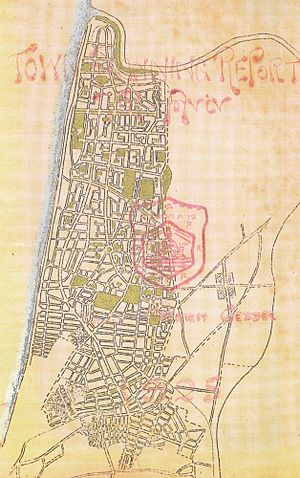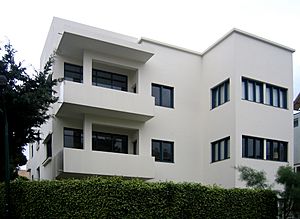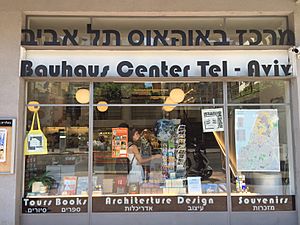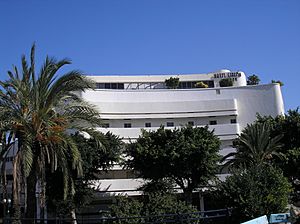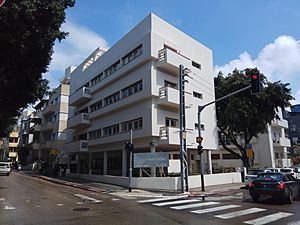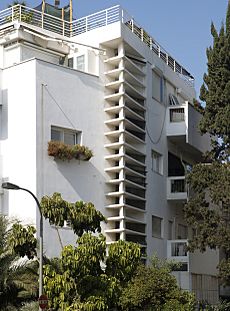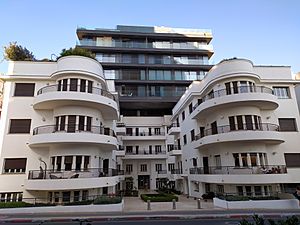White City (Tel Aviv) facts for kids
| UNESCO World Heritage Site | |
|---|---|
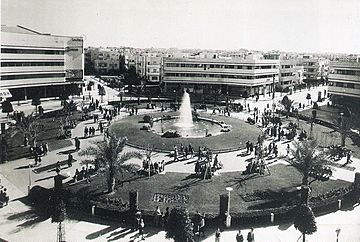
Dizengoff Square in the 1940s
|
|
| Official name | White City of Tel-Aviv – the Modern Movement |
| Location | Tel Aviv, Israel |
| Criteria | Cultural: (ii), (iv) |
| Inscription | 2003 (27th Session) |
| Area | 140.4 ha (347 acres) |
| Buffer zone | 197 ha (490 acres) |
The White City (Hebrew: העיר הלבנה, Ha-Ir ha-Levana) is a special collection of over 4,000 buildings in Tel Aviv, Israel. These buildings were constructed in the 1930s. They show a unique style of architecture called the International Style, often known as Bauhaus.
Many German Jewish architects built these homes. They came to the British Mandate of Palestine from Germany and other parts of Europe. They left their homes after the Nazis came to power in Germany. Tel Aviv has more buildings in the Bauhaus or International Style than any other city in the world.
People have worked hard to save, study, and show off these amazing buildings. In 2003, UNESCO (a part of the United Nations) named Tel Aviv's White City a World Cultural Heritage site. They called it "an outstanding example of new town planning and architecture in the early 20th century." This means it's a very important place for understanding how cities and buildings were designed back then. The city's unique design also fit well with the local culture and climate. You can even take tours to see these buildings with Bauhaus Center Tel Aviv.
Contents
History of the White City
The idea for a new "garden city" called Tel Aviv started in 1909. It was built on sand dunes outside the city of Jaffa. Meir Dizengoff, Tel Aviv's first mayor, asked a Scottish city planner named Patrick Geddes to create a master plan for the new city. Geddes had also planned cities like New Delhi.
Geddes started his work in 1925, and his plan was approved in 1929. The British rulers at the time supported this idea. The city engineer, Ya'acov Ben-Sira, also helped a lot with the city's growth and planning from 1929 to 1951.
Patrick Geddes designed the streets and decided how big the city blocks would be. However, he did not choose a specific building style for the new city. But by 1933, many Jewish architects from the Bauhaus school in Germany had moved to the British Mandate of Palestine. These architects left Germany because the Nazi party came to power in 1933, which also led to the closing of the Bauhaus school in Berlin.
These architects, along with local architects like Ben-Ami Shulman, designed the homes and public buildings. They used the ideas of modern architecture. The Bauhaus style focused on making buildings useful and using affordable materials. This was perfect for Tel Aviv. The architects brought many ideas from Europe, including those from Le Corbusier. Other architects, like Erich Mendelsohn, also worked on projects in Israel during the 1930s. Tel Aviv became a great place to try out many new architectural ideas.
The name "White City" became popular later. Some say it came from an art exhibition in 1984 called White City, International Style Architecture in Israel. Others say it came from the poet Nathan Alterman. This exhibition later traveled to New York. In 1994, a big meeting about the International Style in architecture happened at the UNESCO headquarters. An Israeli artist named Dani Karavan created a sculpture garden there, inspired by the White City. In 2003, UNESCO officially recognized Tel Aviv as a World Heritage Site because of its amazing modern architecture.
Buildings for the Climate
The architects had to change their designs to fit Tel Aviv's hot Mediterranean and desert climate.
- Colors: They used white and light colors for buildings. These colors reflect the sun's heat, keeping the buildings cooler.
- Walls: Walls not only gave privacy but also protected against the strong sun.
- Windows: In Europe, Bauhaus buildings often had large glass windows. In Tel Aviv, these were replaced with smaller windows. These windows were also set back into the walls to block out heat and bright glare.
- Balconies: Long, narrow balconies were common. The balcony above would shade the one below. This design allowed people to enjoy cool breezes from the sea.
- Roofs: Sloped roofs were replaced with flat ones. These flat roofs became common areas where people could meet and relax in the cool evenings.
Some buildings were raised on pillars, called pilotis. The first building like this was the Engel House, designed by Zeev Rechter in 1933. These pillars let the wind blow underneath, which helped cool the apartments. They also created shaded play areas for children. In 1935, the Beit Hadar office building introduced steel frames. This made it easier to open up the ground floor for various uses.
Most of these new buildings were made of concrete. In the summer, they could still get very hot, even with their smart designs. So, people in Tel Aviv would go out in the evenings. They would visit the small parks between buildings and the many coffee shops. This allowed them to enjoy the cooler evening air. This tradition of enjoying outdoor cafes and nightlife continues in Tel Aviv today.
The apartment buildings also offered useful services. These included childcare, postal services, shops, and laundry rooms right inside the buildings. It was also important for people to feel connected to the land. So, residents were encouraged to grow their own vegetables in small garden plots next to or behind their buildings. This helped create a strong sense of community among the residents, who often came from different countries and cultures.
Saving the Buildings
Many of these old buildings, some of them true architectural masterpieces, had been neglected. Some were even torn down before laws were put in place to protect them. However, out of the original 4,000 Bauhaus buildings, many have been fixed up. At least 1,500 more are planned to be saved and restored.
In 2009, the Tel Aviv city government passed laws to protect about 1,000 buildings. In 2015, the German government agreed to help. They promised to give money over ten years to help save these buildings. Some of this money will create a special center in Tel Aviv's Max-Liebling House. This center will help architects and artists work together on preservation projects.
Learning About the White City
A detailed study of the White City by Nitza Metzger Szmuk was later turned into a book. This book was also the basis for an exhibition called "Dwelling on the Dunes." The exhibition first opened in Tel Aviv in 2004. It then traveled to other countries like Canada, Switzerland, Belgium, and Germany.
In 2009, for Tel Aviv's 100th birthday, a special magazine called Docomomo Journal 40 was published. Most of this magazine focused on "Tel Aviv 100 Years: A Century of Modern Buildings." In 2019, an exhibition called "Form and Light" showed photographs of Tel Aviv's White City architecture from the 1930s. This exhibit was held in Lisbon.
Bauhaus Center Tel Aviv
The Bauhaus Center Tel Aviv started in 2000. It works to keep records and information about the city's special architecture. In 2003, it had an exhibition that showed how 25 buildings were being saved. The Center also publishes books about Bauhaus and International Style architecture and the city of Tel Aviv. By 2017, they had published over 15 books on these topics.
Bauhaus Museum
A small Bauhaus Museum opened in Bialik Street in 2008. It is near the old City Hall.
Architects of the White City
Many talented architects helped create the White City. Some of them include:
- Genia Averbuch
- Samuel Barkai
- Jacob Ben-Sira
- Joseph Berlin
- Aryeh Elhanani
- Elsa Gidoni
- Pinhas Huett
- Dov Karmi
- Richard Kauffmann
- Yehuda Magidovitch
- Josef Neufeld
- Zeev Rechter
- Mordechai Rosengarten
- Carl Rubin
- Arieh Sharon
- Ben-Ami Shulman
- Munio Weinraub
See Also
 In Spanish: Ciudad blanca de Tel Aviv para niños
In Spanish: Ciudad blanca de Tel Aviv para niños
- Geddes Plan for Tel Aviv
- Architecture of Israel
- Israeli culture
- Södra Ängby, a modernist neighborhood in Stockholm, Sweden


